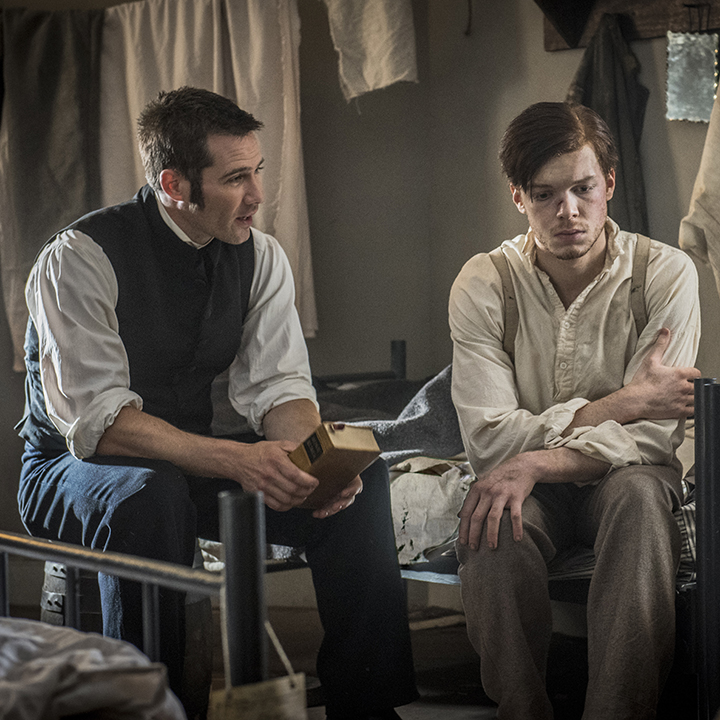Exploring Mercy Street: The Uniform
February 6, 2016 Leave a Comment
Historical fiction is the first draft of legend. If memorable, stories we tell about our family, friends, ancestors and heroes may gain currency over time and take on lives of their own. Using our shared past as inspiration for parable, potboiler and everything in-between is at the root of spinning experience into imagination.
As entertainment, historical fiction is flexible. Stories are anchored to a point in time and accuracy of setting is a basic requirement, but when it comes to plot and characters, there’s more latitude for how closely they’re bound to what we know about the past. Both imagined and historical figures are standard, but their words and actions can be created whole-cloth or drawn as directly as possible from documented record.
When it comes to the American Civil War, two classic battlefield tales exemplify these poles. The Red Badge of Courage, an 1895 novel by Stephen Crane, tells the fictional story of a Union private overcoming his fears through a series of unnamed battles. In contrast, The Killer Angels, a 1974 novel by Michael Shaara, tells the story of Gettysburg in close detail, mostly from the perspectives of several high-profile participants. But most stories fall somewhere between these two approaches, mixing historical reality with original drama.
Mercy Street offers elements of both styles. Set in Alexandria, Virginia, a Union-occupied former slave-trading hub just downriver from Washington D.C., the story centers around two historical buildings: Mansion House Hospital and Carlyle House. It’s late spring 1862, in the midst of the Peninsula Campaign, when a massive Union force is advancing on Richmond. Several major characters are drawn from historical records, notably Union nurse Mary Phinney (Mary Elizabeth Winstead) and some members of the Confederate-sympathizing Green family.
The most prominent character from the Green family is daughter Emma, who becomes a nurse at Mansion House. Also featured are father James Sr. and mother Jane. But son James Jr. is a composite of multiple Green men, and daughter Alice actually died before the war. Several other children are not featured (so far), perhaps cut for reasons of dramatic brevity (or budgetary thrift). And of course, specific ages and locations are altered to suit the show’s plot and conventions of TV drama.
Other Mercy Street characters are fictional creations, though some may be inspired by actual people. Several comparisons are detailed in Emma of Alexandria, a guide assembled by the University of Virginia’s Voting Viva Voce project.
Mercy Street also highlights higher-profile historical figures. The premiere episode opens with Dorothea Dix (Cherry Jones), who was the U.S. Superintendent of Army Nurses during the war and a lifelong advocate for the mentally ill. The second episode features a reference to U.S. Surgeon General William Hammond, considered a medical innovator. Episode three brings the arrival of Frank Stringfellow (Jack Falahee). Beau of Emma Green, this Confederate spy with the given name Benjamin Franklin Stringfellow would attract a $10,000 bounty on his head.
 The third episode, “The Uniform,” finds relationships shifting at Mansion House. Dr. Jed Foster accepts his commission as a Union Army captain, but loses his wife, who decamps for California. Nurse Phinney continues her efforts to feed patients outside the control of grotesque hospital steward Silas Bullen. Both Foster and Phinney face repartee and sarcasm from Dr. Byron Hale and Nurse Anne Hastings, lovers cynical about the war. Wounded Confederate soldier Tom Fairfax, beau to Alice Green, finds respite from soldier’s heart (i.e., PTSD) through chess, and quite a bit of whiskey, in the company of Chaplain Henry Hopkins (Luke Macfarlane).
The third episode, “The Uniform,” finds relationships shifting at Mansion House. Dr. Jed Foster accepts his commission as a Union Army captain, but loses his wife, who decamps for California. Nurse Phinney continues her efforts to feed patients outside the control of grotesque hospital steward Silas Bullen. Both Foster and Phinney face repartee and sarcasm from Dr. Byron Hale and Nurse Anne Hastings, lovers cynical about the war. Wounded Confederate soldier Tom Fairfax, beau to Alice Green, finds respite from soldier’s heart (i.e., PTSD) through chess, and quite a bit of whiskey, in the company of Chaplain Henry Hopkins (Luke Macfarlane).
James Green Sr. faces pressure to sign a loyalty oath to the U.S., but another important historic element is presented almost as an aside. In episode two, Green clashed with a Carolina slave owner who, with the assistance of several Union soldiers, was seeking to capture an escapee. But by May 1862, that was illegal for Union troops per the Act Prohibiting the Return of Slaves passed on March 13. Green seemingly references the new law while speaking to Union army officials who defended the slaver’s actions, but is cut off mid-sentence. This transgression by the soldiers is a curious incongruity, one that evokes an ahistorical tradition of Civil War storytelling. Meanwhile, in a complementary storyline, longtime Green family domestic Belinda Gibson demands a wage — $1.50 per week — from James Sr. to make good the family’s claim that they had freed her. Gibson was encouraged to assert herself by Aurelia Johnson, a contraband working as a laundress at Mansion House.
The primary set piece of the episode, befitting Mercy Street’s identity as a medical drama, is when Dr. Foster amputates the leg of his brother Ezra, a Confederate soldier who arrives at the hospital with a gangrenous wound. High on morphine, the doctor conducts this surgery with the assistance of nurses Phinney and Green, who are establishing a working relationship. The procedure is depicted in graphic detail and concludes memorably with a montage set to “One Morning Soon,” a traditional spiritual (archived by the Library of Congress).
Singing this tune is Miles (Myron Parker, Jr.), an adolescent slave owned by the Foster brothers’ mother. While doing laundry in the hospital yard, Johnson and the freeborn Samuel Diggs assure Miles that his owner sees him as nothing more than property, and urge him walk away and claim his freedom. Johnson even alludes to the new federal law, saying, “You want to be free, you gotta take it!” The young man does make this choice, and his self-directed emancipation is a soaring culmination to the episode. His story of embracing liberty is the first in which the show’s African-American characters move beyond background status, and bodes well for the second half of the season.
Mercy Street‘s producers and others at PBS have touted the show’s focus on historical detail, but the show’s growing dramatic confidence warrants attention too.
Watch the full episode of “Mercy Street: The Uniform” online now:
 Passport
Passport





